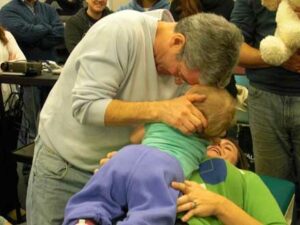pediatric chiropractic
why it’s important
The period from birth to age two is the most dynamic and important phase of brain development in humans. It is a critical period in the child’s neurodevelopment. Interference or damage to the child’s nervous system during this period will have far reaching and permanent effects on the child’s potential and developmental capabilities. These effects will be global in nature and can affect the nervous, immune, hormonal, homeostatic, cognitive, behavioral, organ, and functional capacity of the child.
Birth trauma is also responsible for creating subluxations in the infant’s spine. Assisted deliveries, including: C-sections, forceps, vacuum and induction procedures increase the chance of neurological damage to the infant’s spine and nervous system. While many of these traumas go undetected at the time of occurrence diverse symptoms and conditions can occur later in life as a result of these uncorrected subluxation patterns. Damage in these instances often occurs to the upper cervical (neck) spine and brain stem but traumatization of other levels of the spine are also prevalent.
“Traumatization of the suboccipital structures inhibits functioning of the proprioceptive feedback loops. The motor development, though preprogrammed, cannot develop normally. These systems are fault tolerant and able to overcome considerable difficulties and restricted working conditions. But the price for this is a reduced capacity to absorb additional stress later. These children may show only minor symptoms in the first months of their life but later on at the age of 5 or 6 they suffer from headaches, postural problems or diffuse symptoms like sleep disorders, being unable to concentrate etc.”
Journal of Manual Medicine, Springer - Velag 1992
The first six years of life
During the first six years of life, as 90% of your child’s neurological development is completed, it is important to have their spine checked for subluxations that can create abnormal compensatory patterns that they carry into adulthood and affect their overall health and development. These neurological / functional / biomechanical / adaptive / dysfunctional patterns, known as subluxations, can occur when external or internal stresses are too much for the body to adapt to in a positive manner and an “overload” occurs in the body to compensate for this process. If this compensation goes uncorrected it will then become the new “norm” from which the nervous system will now function. This new “norm” that is created is usually a negative adaption that creates a lower functional threshold in the nervous system leaving it more susceptible to dis-ease and dysfunction.
Timeline
| In the first year of life 1000-100,000 synapses are created between each neuron. | The brain reaching 80-90% of adult volume by age 2 (Pfefferbaum et al., 1994). |
| The brain grows 2 – 3 times is birth size | The rapid elaboration of new synapses in the first two years of life (Huttenlocher and Dabholkar, 1997; Glantz et al., 2007) corresponds with an increase in overall gray matter volumes to a lifetime maximum around age 2 (Hu®ppi et al., 1998; Matsuzawa et al., 2001; Gilmore et al., 2007b). |
| The cerebellum grows 240% | Myelination of white matter proceeds rapidly after birth 90% in the first 2 years. The general pattern of adult myelination is present by the end of the second year (Sampaio and Truwit, 2001), although myelination does continue, at a slower rate, far into adulthood. |
| By age two 80-90% of the adult volume of gray matter is formed and myelination of most of the spinal tracts has been accomplished (full myelination occurs by age 10) | Concurrent with the rapid pace of structural brain development is an equally rapid development of a wide range of cognitive and motor functions (Kagan and Herschkowitz, 2005). |
| Total brain volume increase 110% in the first year and 15% in the second | Because the cerebellum is critically involved in motor coordination and balance (Bastian and Thach, 2002), the striking cerebellar growth may underpin the rapid motor developments of infancy (pre-programmed proprioceptive feedback loops). |
| The majority of hemispheric growth especially the gray matter increases 149% in the first year | The cerebellum has also been implicated in a plethora of other cognitive abilities including planning, set-shifting, language abilities, abstract reasoning, working memory, and visual-spatial organization (Schmahmann and Sherman, 1998). |
| The lateral ventricle volume increases 280% in the first year. | Given that “cognitive” regions of the cerebellum have reciprocal projections with nonprimary frontal, parietal, and occipital association cortex (Thach, 1996), the extremely rapid growth of the cerebellum in the first year may be a prerequisite for specific aspects of later cortical development. |
The only true subluxation you ever see must be in a child prior to the age of seven years. If this subluxation goes uncorrected it becomes a primary source of stimulus through life, but the tombs of distortion, which form from one traumatic experience to the other, soon bury this primary subluxation under that ‘tomb of distortions.’ The subluxation that all of us worry about occurred some time between birth and the seventh year of life, and the remedy would of course be careful chiropractic care from birth through the seventh year of life.
Major Bertrand De Jarnette, DO, DC
Major Bertrand De Jarnette the founder and developer of Sacro Occipital Technique (SOT) realized the importance of chiropractic care in children early on in his career. While he developed the SOT system of chiropractic to deal with all ages the sophistication and safety of this technique makes it a perfect match for adjusting the pediatric patient.
Besides the spinal cord and nervous system insults that occur during the birth process there are a myriad of traumas and injury that can cause damage and dysfunction to the nervous system.
Why Should Children Receive Regular Chiropractic Care
Recurrent micro or macro-traumas including:
- Sports injuries
- Auto accidents
- Falls
- Traumatic emotional events
- Food sensitivity and reactivity (viscerosomatic response)
- Toxic environments
- Drugs
The importance of keeping your spine and nervous system functioning to its optimum potential is paramount to your overall health and well-being. Studies have shown chiropractic adjustments to be effective in:
| Reducing subluxations | Normalizing brain wave patterns (through QEEG studies) |
| Increasing circulation and blood supply to the brain. | Improving neurological function through autonomic nervous system rebalancing |
| Reducing impaired motor balance that affects reaction time. | Reducing excessive signaling from the involved intervertebral muscles (spasms) and therefore changing the way the CNS (central nervous system) responds to subsequent input. This alters how the nervous system responds to the environment. |
| Activating and coordinating specific neurological pathways. | Increasing reduced nerve response |
| Reducing nerve facilitation and hyperirritability. | Increasing the quality and quantity neural inputs to the CNS. |
| Increasing and balancing the movement of CSF (cerebro spinal fluid) throughout the CNS | Improving immune system function. |
| Increasing the threshold at which negative genetic predispositions are activated. | Restoring normal Basal Metabolic Rates (BMR) |
| Increasing individual threshold levels and adaptive responses. | Adjustments may “reboot the nervous system resetting abnormal neurological patterns and restoring healthier more normal neurological patterns (neuroplasticity). |
“Birth related spinal cord injuries appears to be under diagnosed. Severe injuries cause death immediately; incomplete injuries can either cause death within the neonatal period or permit survival. In birth injuries, the upper cervical spine or the cervicothoracic junction is usually affected. However, and level of the spinal cord can be involved, and the involvement of multiple levels is not uncommon.”
Dickman, Rekate, Sonntag, Zabramski Division of Neurological Surgery, Barrow Neurological Institute, Phoenix, AZ.
It is apparent that damage to the spine and nervous system during the development of reactive neurological stress patterns can cause compensatory patterns to either be learned or occur naturally, which will allow the individual to interact with their environment to the best of their ability, but with less than optimal function. These compensations can cause a decrease in functional capability, adaptive response, and decreased stress thresholds and therefore a decreased state of health.



